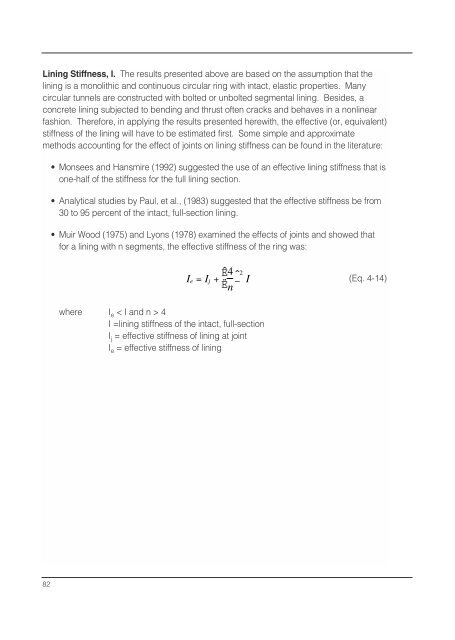Seismic Design of Tunnels - Parsons Brinckerhoff
Seismic Design of Tunnels - Parsons Brinckerhoff
Seismic Design of Tunnels - Parsons Brinckerhoff
Create successful ePaper yourself
Turn your PDF publications into a flip-book with our unique Google optimized e-Paper software.
Lining Stiffness, I. The results presented above are based on the assumption that the<br />
lining is a monolithic and continuous circular ring with intact, elastic properties. Many<br />
circular tunnels are constructed with bolted or unbolted segmental lining. Besides, a<br />
concrete lining subjected to bending and thrust <strong>of</strong>ten cracks and behaves in a nonlinear<br />
fashion. Therefore, in applying the results presented herewith, the effective (or, equivalent)<br />
stiffness <strong>of</strong> the lining will have to be estimated first. Some simple and approximate<br />
methods accounting for the effect <strong>of</strong> joints on lining stiffness can be found in the literature:<br />
• Monsees and Hansmire (1992) suggested the use <strong>of</strong> an effective lining stiffness that is<br />
one-half <strong>of</strong> the stiffness for the full lining section.<br />
• Analytical studies by Paul, et al., (1983) suggested that the effective stiffness be from<br />
30 to 95 percent <strong>of</strong> the intact, full-section lining.<br />
• Muir Wood (1975) and Lyons (1978) examined the effects <strong>of</strong> joints and showed that<br />
for a lining with n segments, the effective stiffness <strong>of</strong> the ring was:<br />
Ê<br />
I e = I j + 4 Ë ˆ¯<br />
2<br />
I<br />
n<br />
(Eq. 4-14)<br />
where I e < I and n > 4<br />
I =lining stiffness <strong>of</strong> the intact, full-section<br />
I j = effective stiffness <strong>of</strong> lining at joint<br />
I e = effective stiffness <strong>of</strong> lining<br />
82
















